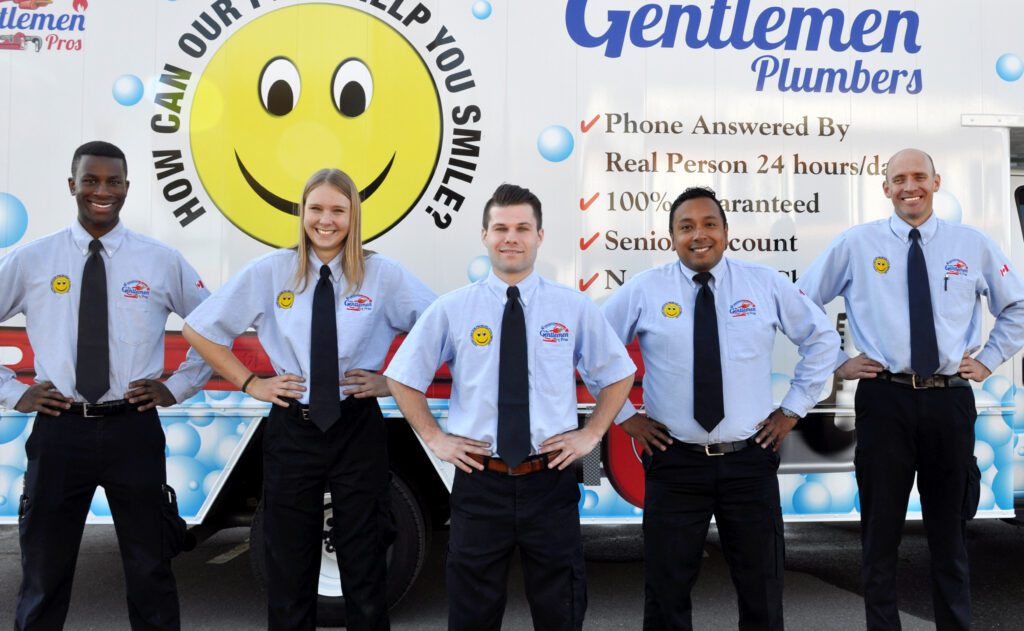
Same Day Service Since
2001
Call The Gentleman Pros Now!
(587) 404-1021

Once you have narrowed down your list of heating contractors you need to turn your attention to what you need and want in a furnace.
Three things impact your choice in a furnace:
Each heating company on your list should recommend an in-home consultation. If they don’t, they shouldn’t be on your list.
During an in-home consultation, the company representative, often called a comfort advisor, will analyze your heating needs, taking into consideration your house, the climate, and your wants and needs.
During their visit, the comfort advisor should conduct a comfort survey. This means they will ask you a lot of questions and perform some calculations. The information they collect will determine the furnace size, the AFUE rating, and the features and add-ons they will recommend. These items are explained in Section 3 -The Different Types of Furnaces and How They Work.
[For more information on what should happen during a home visit, check out What Does A Comfort Advisor Do?.]
If a company will not provide a home visit, strike them off your list. Choosing a furnace is very specific to each home and family and not something that can be done over the phone.
A good comfort advisor provides recommendations and information on:
One of the most important recommendations you will get from the comfort advisor is the size furnace.
And by size, I don’t mean the physical dimensions of the furnace. I mean how much heat will the furnace produce that can be used to heat your home.
Well, how do they determine that? They need to conduct a heat load analysis.
But before we get into the ins and outs of a heat load analysis, we are going to cover what your heating contractor shouldn’t do to determine furnace size.
You will not get a properly sized furnace by:
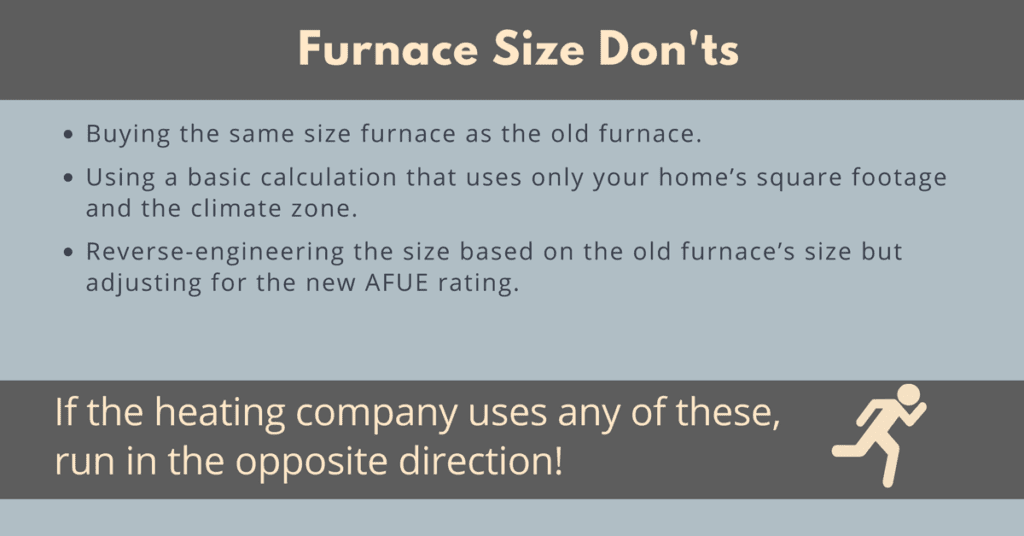
If the heating company uses any of the above, run in the opposite direction. We cannot stress this enough! They are using generic information and taking major shortcuts and you will end up with an undersized or oversized furnace, and if they are taking shortcuts this early in the game, what shortcuts will they take during installation?
Problems with an Oversized Furnace
People think the bigger and more powerful a furnace, the better it will heat their home. This is not true, an oversized furnace comes with some issues.
Problems with an Undersized Furnace
An undersized furnace has its own set of issues.
This leads to an important question.
How do you ensure you are getting a properly sized furnace?
The answer is your comfort advisor must do a thorough heat load calculation.
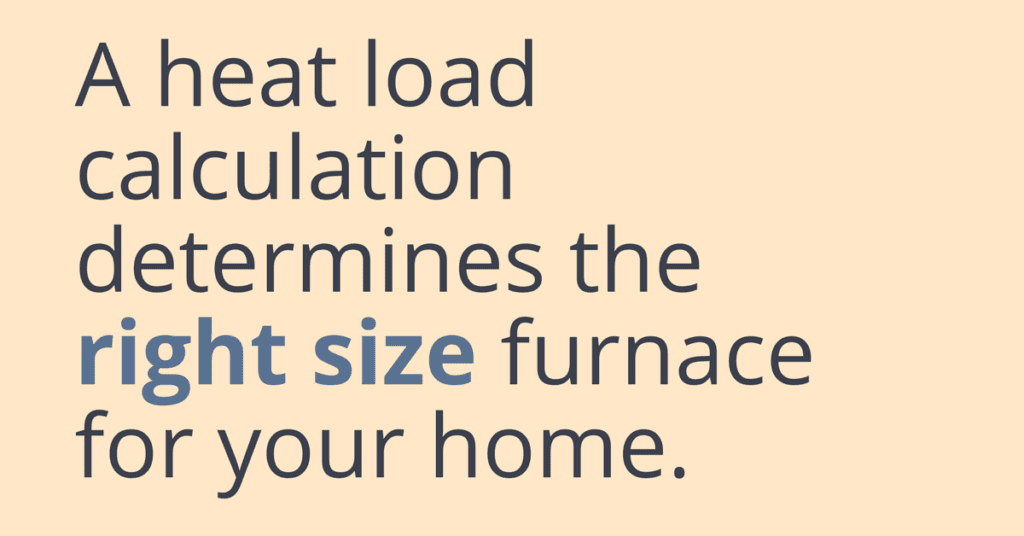
What is Heat Load?
Heat load is the amount of heat a building needs to keep the indoor temperature at a set level, measured in BTUs. All sources of heat loss are combined with all sources of heat gain to estimate the heat load.
If the heat loss is greater than the heat gain, then heat from another source — like a furnace — must be added to maintain your desired temperature. The needed extra heat — heat load — determines the heat capacity or size of the furnace you are buying.
How Do You Calculate Heat Load?
There is more than one way to calculate heat load.
In Canada, most provinces and territories, including Alberta, require the size of a furnace to be determined using the heat load calculation method outlined in the Canadian Standards Association (CSA) standard F280, “Determining the Required Capacity of Residential Space Heating and Cooling Appliances.”
In the United States, they use the method outlined in the Air Conditioning Contractors of America (ACCA) Manual J. Sometimes the heat load calculation is referred to as a Manual J calculation.
However, the industry is loosely monitored and some heating companies may not use a heat load analysis, they use the rule of thumb method which really is just a guesstimate.
Other companies will calculate the heat load using the various spreadsheet models or HVAC design software on the market.
Ask the heating company which method they use and why. Don’t be afraid to google their method to see how it measures up. You want to make sure they conduct a thorough heat load calculation using an appropriate calculation.
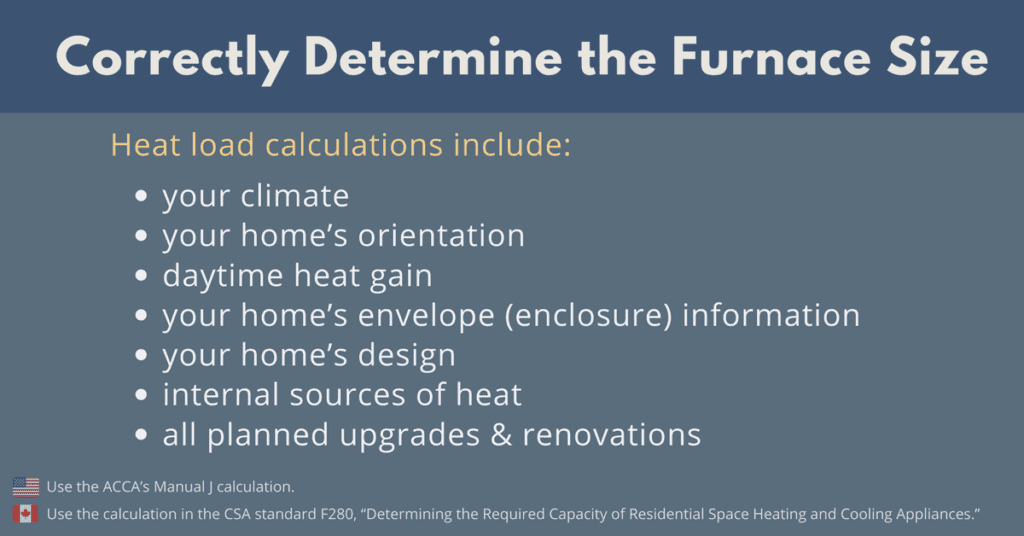
So, What Exactly is Included in a Heat Load Calculation?
Depending on the method and what the applicable regulation(s) stipulates, a heat load calculation includes a combination of these data points:
When you look at the above list, you can clearly see that a lot of factors influence the size of your new furnace and how the size is very specific to your home.
In addition to the furnace size, you also need to decide on what features and add-ons you want.
This consists of two things, the furnace’s:
Annual Fuel Utilization Efficiency (AFUE) Rating
How efficiently do you want your new furnace to turn natural gas into useable heat? In Canada, a furnace must have a minimum AFUE rating of 95 percent. Currently, the highest AFUE available in Canada is 99 percent.
You will need to decide if the benefits of a higher AFUE offset the costs. A higher AFUE usually means a higher price. There are online calculators you can use to help you with this decision.
Electricity
Yes, gas furnaces use electricity. Electricity powers the electronic ignition system (this has replaced the pilot light in new furnaces) and the furnace’s fans. If you are concerned about your electricity usage, you should consider a furnace with an ECM fan. They use less electricity than a PSC fan.
Your new furnace’s level of energy efficiency isn’t purely a financial decision. Many are concerned about their carbon footprint and want to use less energy. This will factor in their decision.
The more stages your furnace has, the more efficient it is, the more consistent the temperature, the more evenly your home is heated, and the more expensive the furnace. If you want help saying goodbye to wasted energy, temperature fluctuations, and cold spots, a two-stage or modulating furnace is your best choice.
This is the time to seriously think of any add-ons you want. Add-ons include air conditioners, humidifiers, air exchangers, air purifiers, and programmable thermostats. Buying and installing them with your new furnace will increase the upfront and installation costs.
There are a few benefits of doing it all together.
Zoned heating is another way to increase energy efficiency and eliminate cold and hot spots. If you want it, it will impact the type of furnace you get. That’s because a zoned heating system won’t work with a single-stage furnace. It will work with a two-stage furnace, but it works best with a modulating furnace with a variable speed fan.
And last, but definitely not least, you have to think about the financial sides of things.
This is more than just what can I afford right now? You need to consider:
Your upfront cost is the initial price you pay for your furnace. Operating costs are what it costs to run your furnace. When you upgrade to a higher efficiency furnace, your operating costs usually go down.
Payback Period
This is the period of time it will take for the money you save on your lower monthly heating bills to cover the extra money you paid upfront for a higher efficiency furnace.
From a purely financial viewpoint, buying a furnace is an investment and you need to know how long it will take to recover the increased cost of a more expensive model. Only you can decide if the payback period is acceptable.
Also, remember you will only get the stated furnace efficiencies if the furnace is properly installed.
Your primary residence is where you and your family live. Where you pay the gas bill and where you want to experience an optimal level of comfort. These are good reasons for contemplating investing in a higher efficiency furnace with multiple stages and add-ons, such as zoned heating, humidity control, or air quality.
If you are buying a new furnace for a rental property and your tenants are responsible for the utility bills, it might be a better business decision to purchase a furnace with a lower upfront price but higher operating costs.
Also, In a rental, investing in multiple stages and various add-ons may not make financial sense. You will need to see if your local rental market is willing to pay for higher home comfort. You may find that tenants are willing to pay higher rent for air conditioning but not for a higher efficiency furnace and add-ons.
Why is this a consideration? Because if you plan on being in this home for the long haul, it can make financial sense to pay more upfront for a higher efficiency model. You will use the furnace long enough for the lower operating costs — gas bills — to offset the higher initial price.
If the payback period is longer than you plan to stay in the house, you will not recoup your upfront spending from the lower operating costs. You might want to look at a less expensive furnace with a shorter payback period.
If you plan on selling, you should also consider which furnace model will give you the greatest increase in the value of your home.
Various organizations offer furnace rebates and companies have sales. Ask your comfort advisor if there are any sales and rebates for the recommended furnaces and any comparable models. Also, ask if any higher models have rebates or sales. The money you save could put the higher model into your budget range.
A nice rebate or sale could sway your decision in one direction or another.
National Resource Canada has a database for rebates for ENERGY STAR furnaces.
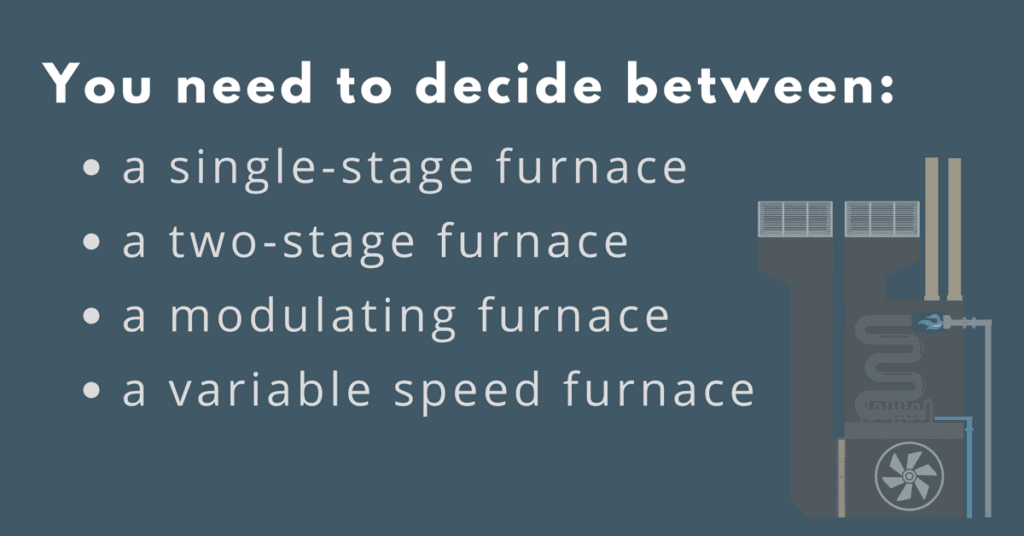
Now you know how to choose your contractor and furnace. The next step is to gather some quotes. I recommend a minimum of three.
But once you get the quotes, how do you know which one is the best one for you?
The next section deals with comparing quotes.
